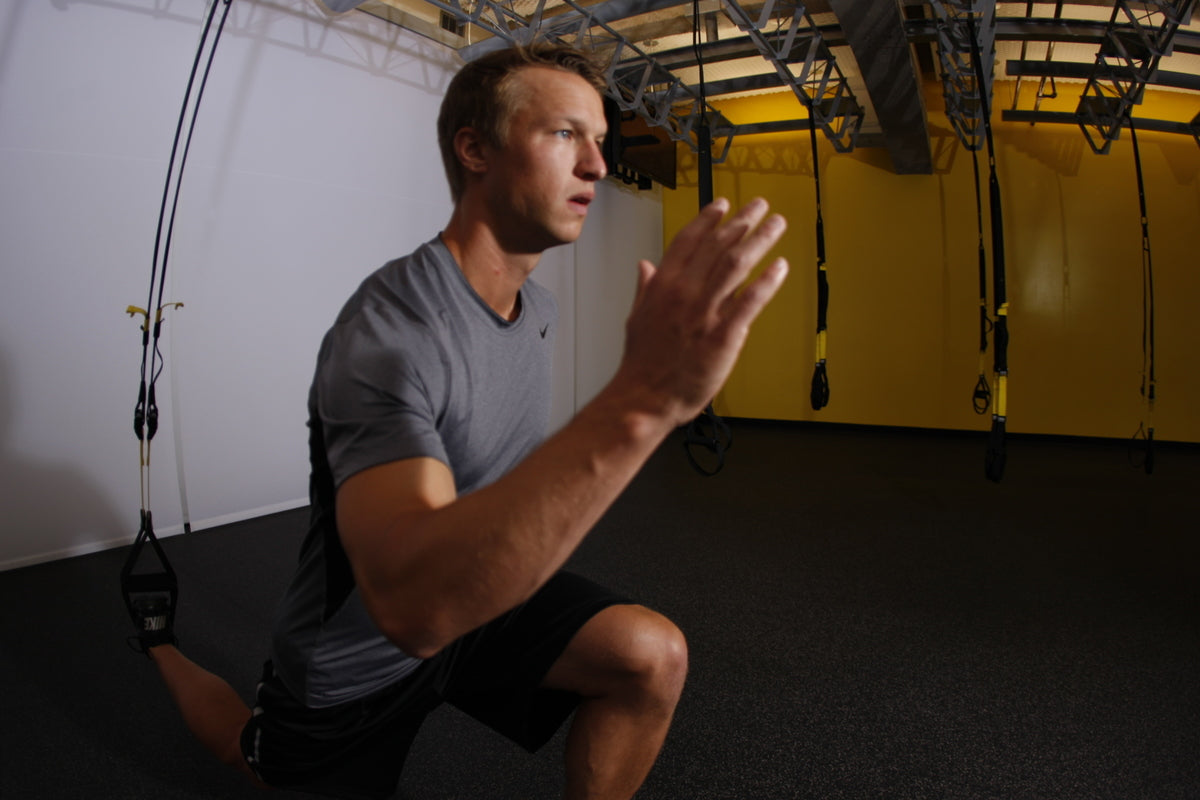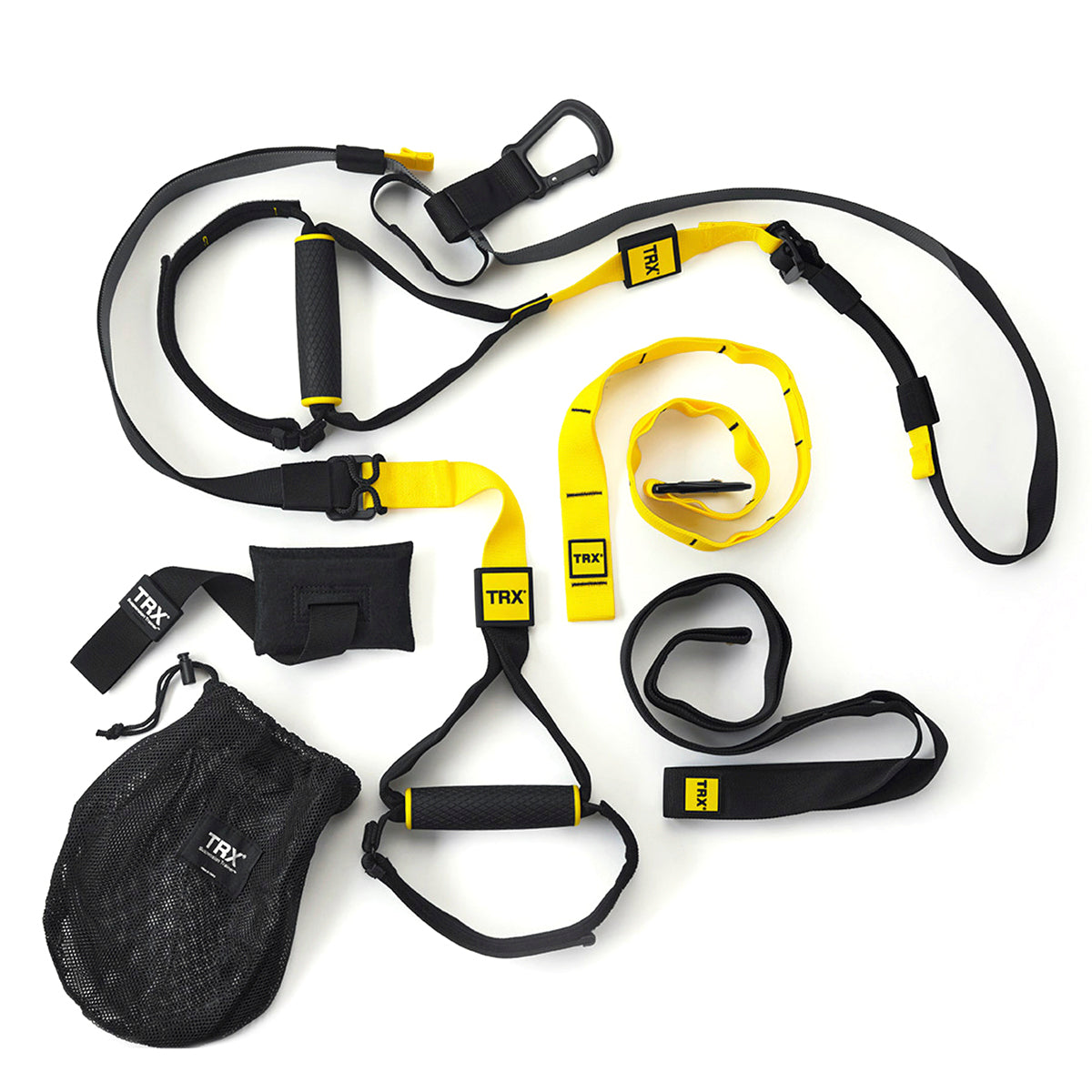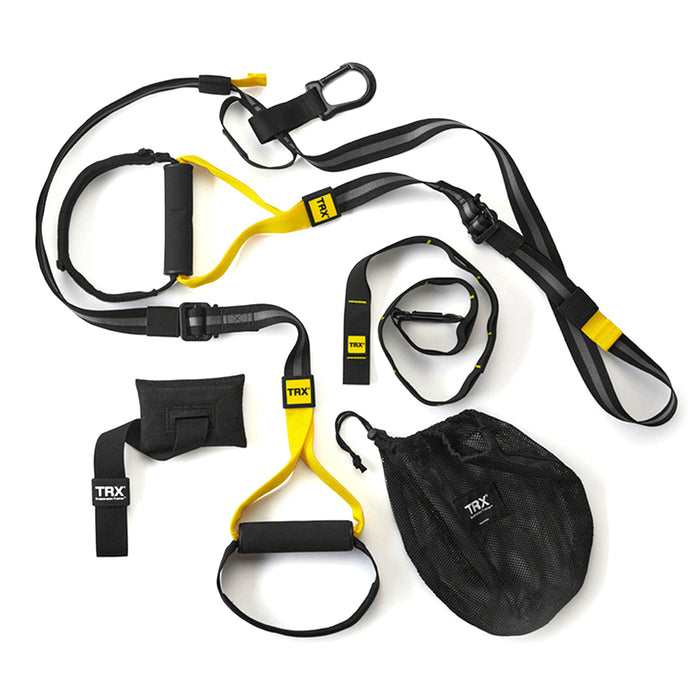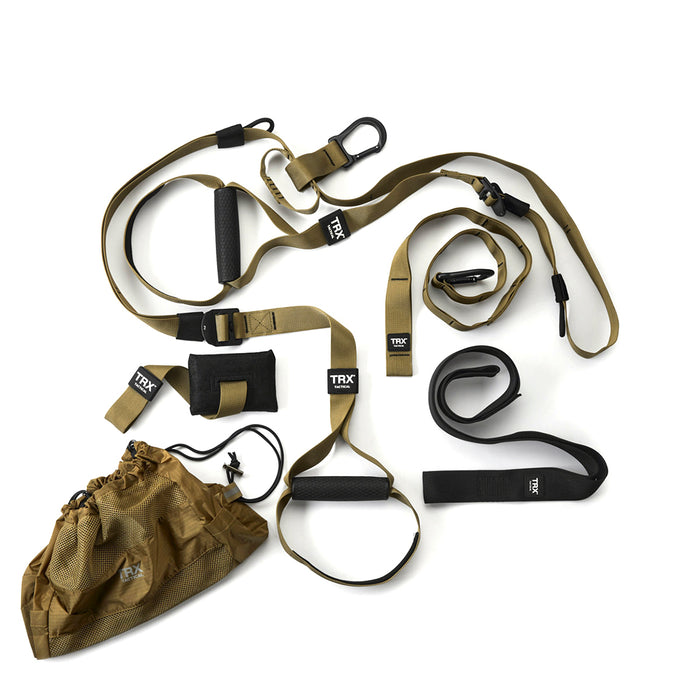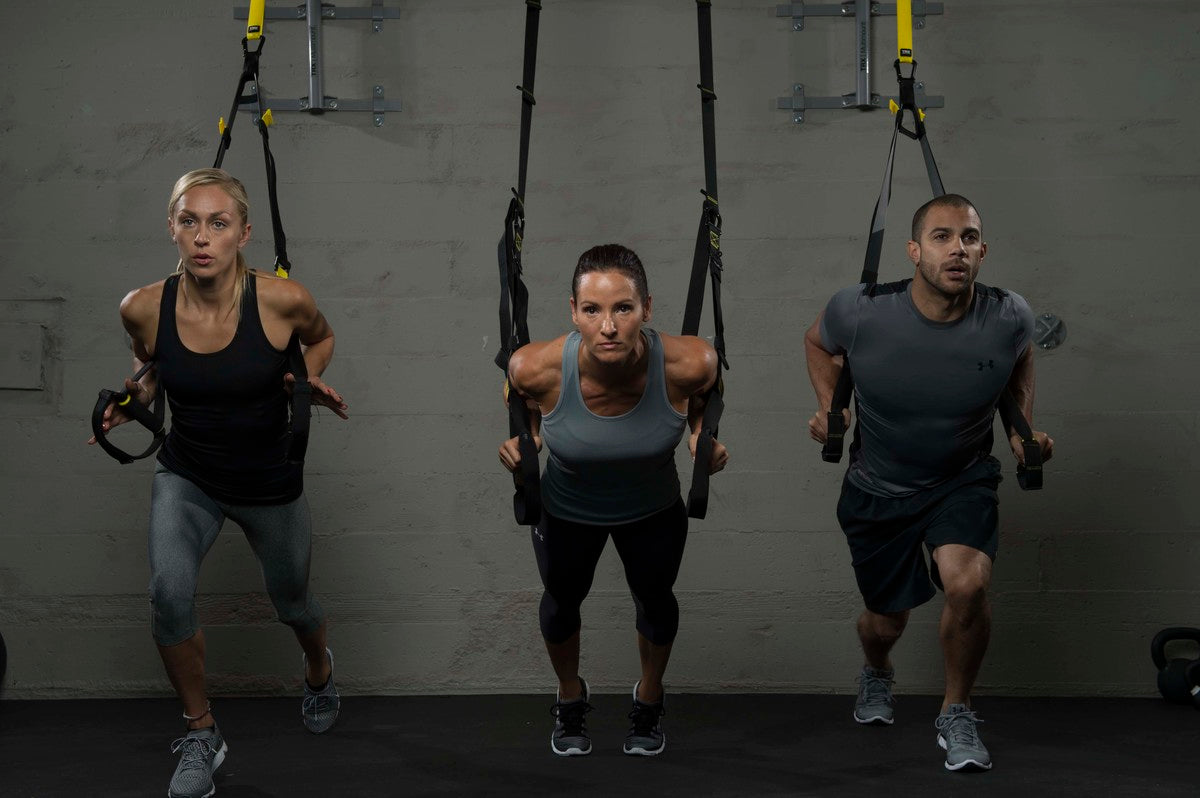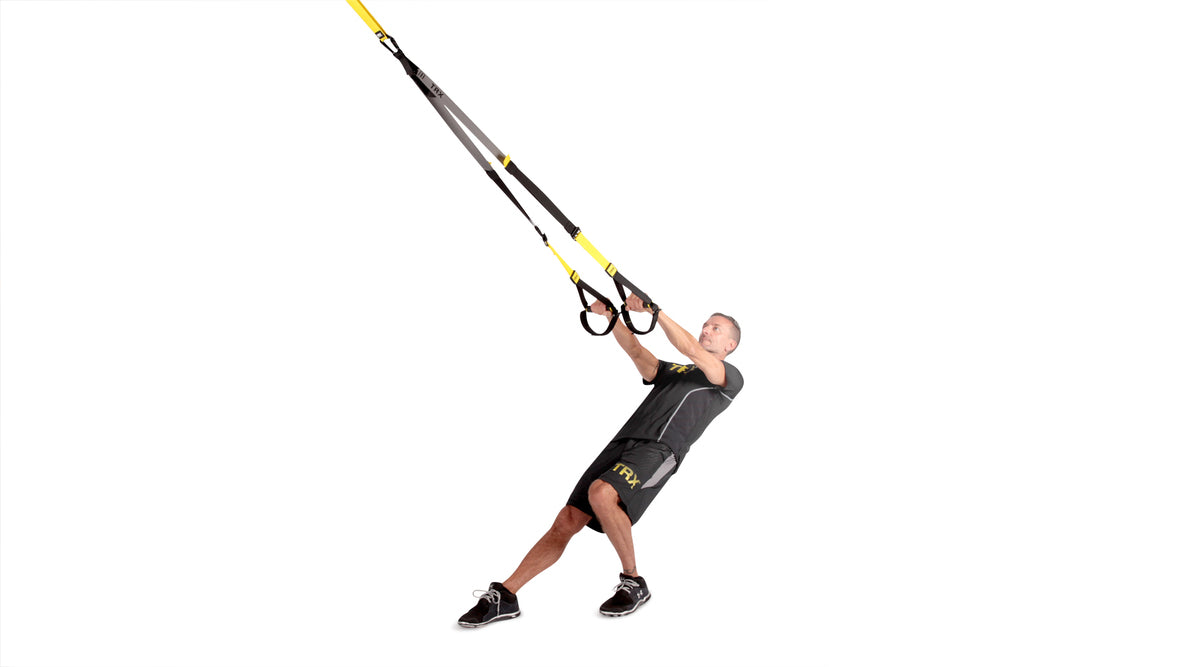When it comes to lower body workouts, TRX exercises offer an array of benefits, from enhancing muscle tone and strength to improving overall flexibility and stability. This guide dives into ten effective TRX leg exercises designed to sculpt and strengthen the lower body, enabling individuals to leverage their own body weight to achieve remarkable fitness results.
10. TRX Glute Bridges
TRX Glute Bridges primarily target the gluteal muscles, including the gluteus maximus, which is the largest of the three glute muscles. Additionally, this exercise engages the hamstrings, core stabilizers, and lower back muscles.
- Adjust the TRX straps to fully lengthened.
- Lie on your back, with your head under the anchor point (if using a door anchor your head with be a couple of inches away from the door)
- Place your heels placed securely in the foot cradles of the straps.
- Bend your knees to 90 degrees, ensuring that your feet are flexed and hip-width apart.
- Engage your core and press your heels into the foot cradles, this is your start position
- Tuck your tailbone and lift your hips off the ground.
- At the top of the movement, there should be a diagonal line from your shoulders to your knees.
- Squeeze your glutes at the top of the movement, pause briefly, and then slowly lower your hips back down to the starting position.
The benefits of TRX Glute Bridges extend beyond merely sculpting the glutes. By performing this exercise, individuals can effectively strengthen the posterior chain, which contributes to improved posture, stability, and athletic performance. Stronger glutes not only aid in enhancing overall lower body strength but also play a crucial role in preventing injuries, particularly in the lower back and knees. Incorporating TRX Glute Bridges helps individuals develop better control over their pelvic and hip movements, translating into improved functional mobility in everyday activities.
9. TRX Crossing Lunges
TRX Crossing Lunges predominantly target the quadriceps, hamstrings, and gluteal muscles. The primary emphasis of this exercise is on the inner and outer thighs, due to the curtsy lunge motion. Additionally, the stabilizing muscles of the core and lower back are engaged to maintain balance and proper posture during the exercise. The emphasis on these various muscle groups helps to improve overall lower body strength, stability, and functional movement patterns. This exercise aids in enhancing balance and coordination, making it an excellent addition to a comprehensive lower-body workout routine.
- Set the TRX straps to short
- Start by holding the rubber handles at chest height, with tension on the straps.
- Stand facing the anchor point with your feet shoulder-width apart. Keep your core engaged for stability.
- Shift your weight onto one leg while crossing the opposite leg behind it, lowering yourself into a lunge position. Ensure both knees are bent at a 90-degree angle, with your back knee crossing behind your front heel.
- Push through the heel of your front foot to return to the starting position.
- Alternate sides and repeat the movement, focusing on controlled and steady movements throughout.
8. TRX Hip Presses
- Set the straps to mid-calf length and face the anchor point.
- Lie on your back with your heels in the foot cradles, legs extended straight
- Keep your arms grounded by your sides for stability.
- Press your heels into the foot cradles and lift your hips off the ground, engaging your glutes and core.
- Bend your knees into a hamstring curl and hold
- Press your hips up to a glute bridge position, without your feet moving away from you.
- Lower your hips, maintain the hamstring curl, and repeat for the desired number of reps
To increase intensity, move further away from the anchor point to increase resistance. Alternatively, for a modified lighter resistance follow the above steps for the TRX Glute Bridge, by changing position to head under the anchor point. Additionally, adding variations such as single-leg hip presses or pulsing movements at the top of the press can intensify the workout and further engage stabilizing muscles. Integrating tempo changes, such as slowing down the lowering phase or incorporating isometric holds at the top, can enhance the overall effectiveness of TRX Hip Presses. These variations cater to different fitness levels and enable individuals to progress gradually while continuously challenging their lower body strength and stability.
7. TRX Squat Jump
The TRX Squat Jump is a dynamic exercise aimed at enhancing lower body power and explosiveness.
- Stand facing the anchor point with the TRX straps set to a short length.
- Hold onto the handles at chest level, maintaining an upright posture with your feet shoulder-width apart. Avoid leaning back on the straps
- Initiate the movement by performing a standard squat—bend your knees and hips, lowering your body down while keeping your chest up and weight on your heels.
- As you reach the bottom of the squat, explode upward forcefully, extending your legs to propel yourself off the ground.
- Land softly back into the squat position, ensuring a controlled descent to absorb the impact.
- Repeat for the desired number of reps
The TRX Squat Jump offers a myriad of benefits, especially in terms of lower body power and cardiovascular health. This explosive movement engages major muscle groups including the quadriceps, hamstrings, glutes, and calves, promoting strength and power development. By incorporating plyometric movements like the Squat Jump, individuals can improve their muscular endurance, explosiveness, and overall athletic performance. Moreover, the rapid nature of this exercise elevates heart rate, contributing to improved cardiovascular health and enhanced calorie burning. This combination of strength-building and cardiovascular benefits makes the TRX Squat Jump an efficient and impactful addition to a lower-body workout routine.
Tip: Combine this with our TRX Push-Up for an easy strength training routine at home.
6. TRX Side-to-Side Lunge
- Adjust the TRX straps to a short length and stand facing the anchor point.
- Grasp the handles with both hands, hands at chest height, maintaining a shoulder-width stance.
- Step to the side with one leg while keeping the other foot securely planted.
- Lower your body into a lateral lunge by bending the knee of the stepping leg and sitting your hips back, while keeping the non-stepping leg straight.
- Maintain form by ensuring a straight back, upright chest, and engaged core for stability.
- Push through the heel of the lunging leg to return to the starting position.
- Alternate sides by repeating the movement with the opposite leg, ensuring controlled and deliberate motions throughout.
Incorporating lateral movements, such as the TRX Side-to-Side Lunge, into leg strength training is pivotal for a well-rounded lower-body workout. While traditional exercises like squats and lunges predominantly focus on forward and backward movements, lateral movements play a crucial role in developing stability, balance, and functional strength. These movements engage muscles in a different plane of motion, targeting the inner and outer thighs, hip abductors, and adductors that might not be activated as extensively in other exercises. Strengthening these muscles through lateral movements aids in improving overall lower body stability, reducing the risk of injuries, and enhancing athletic performance. Moreover, lateral exercises like the TRX Side-to-Side Lunge promote improved agility and mobility, making daily activities that involve lateral movements easier and more efficient. Integrating lateral movements into leg strength training ensures a well-balanced approach, effectively targeting muscles from various angles to promote comprehensive lower body strength and stability.
First, here's what you'll need:
5. TRX Mountain Climbers
- Adjust the TRX to mid-calf, set up ground facing with toes in the foot cradles.
- Begin in a plank position, with your feet flexed
- Keep your hands directly under your shoulders and your body forming a straight line from head to heels.
- Engage your core muscles to maintain stability throughout the exercise.
- Alternate driving your knees towards your chest in a marching motion while equal tension on the straps to avoid sawing.
- Maintain control and aim for a smooth, continuous movement pattern throughout the exercise.
TRX Mountain Climbers inherently engage the core due to the plank position and the dynamic knee drive. To amplify the engagement of the core muscles, focus on pulling your navel towards your spine and maintaining a strong, stable core throughout the exercise. Ensure your hips are level and avoid sagging or lifting them too high. Engaging the core not only intensifies the workout but also helps in developing core strength, stability, and endurance.
By actively involving the core muscles during TRX Mountain Climbers, individuals can experience an added layer of challenge and effectiveness in targeting the abdominal muscles. This exercise not only promotes cardiovascular endurance and lower body strength but also serves as a compound movement engaging multiple muscle groups, contributing to a more comprehensive workout session.
4. TRX Abducted Lunges
- Start by adjusting the TRX straps to mid-calf length and standing sideways to the anchor point.
- Hold both the handles with one hand and place the foot closest to the anchor point into the foot cradle, maintaining tension in the straps.
- Stand tall, with one foot inside the foot cradle and the other foot planted firmly on the ground.
- Lower yourself into a side lunge by bending the knee of the grounded leg while keeping the suspended leg straight and extended to the side.
- Push through the heel of the grounded leg to return to the starting position, ensuring controlled movements throughout the exercise.
TRX Abducted Lunges primarily target the adductor muscles, outer thighs, glutes, and quadriceps. This exercise not only strengthens these muscle groups but also enhances flexibility in the hip adductors and abductors due to the wide range of motion involved. The abduction of the suspended leg challenges the lateral stability muscles, aiding in better balance and stability. Consistent practice of TRX Abducted Lunges can lead to improved flexibility in the inner thighs and hips, contributing to better overall lower body mobility and reduced risk of injuries related to tightness in these areas. Incorporating this exercise into a routine not only builds lower body strength but also promotes flexibility, making it a valuable addition to a well-rounded workout regimen.
3. TRX Squats
- Begin by adjusting the TRX straps to a short length and standing facing the anchor point.
- Hold the handles with both hands, keeping them at chest level. Ensure your feet are shoulder-width apart, maintaining good posture with your chest up and shoulders back.
- Initiate the squat by lowering your body down, and bending at the hips and knees while keeping your weight in your heels.
- Work with your range of motion, aim to lower yourself until your thighs are at least parallel to the ground, working towards your hip crease being lower than your knees.
- Track your knees outside your middle toes. Engage your core muscles throughout the movement.
- Hinge your body forward slightly, keeping your elbows bent to avoid hanging off the straps, this will keep the work in your legs
- Push through your heels to return to the starting position.
TRX Squats are an excellent compound exercise that targets multiple muscle groups simultaneously, including the quadriceps, hamstrings, glutes, and calves. By engaging these major muscle groups, TRX Squats help build overall lower body strength and power. The TRX provides support to allow you to focus on your form and work to build your range of motion. This exercise translates well into functional movements, benefiting daily activities that require squatting motions. Regular practice of TRX Squats contributes to improved lower body strength, endurance, and functional fitness, making it a valuable addition to a comprehensive lower body workout regimen.
2. TRX Hamstring Curls
- Adjust the TRX straps to a mid-calf length and lie on your back facing the anchor point.
- Place your heels securely in the foot cradles, lie down with your legs straight, keeping your arms by your sides and palms flat on the ground for stability.
- Lift your hips off the ground to form a straight line from shoulders to heels.
- Engage your core muscles throughout the exercise to avoid your hips moving
- Flex your feet and press your heel firming into the foot cradles
- Bend both knees simultaneously drawing your heels towards your glutes
- Pause at the end range and then straighten your legs with control to return to the start position.
If you’re looking for convenience, TRX Hamstring Curls are a highly effective hamstring exercise to do at home. The movement targets the hamstring muscles, which are crucial for knee flexion and hip extension. Strengthening the hamstrings helps improve athletic performance, stability, and overall lower body strength.
Strong hamstrings also contribute to injury prevention, particularly in activities involving explosive movements or sudden changes in direction. Weak hamstrings can increase the risk of strains or injuries, especially during sports or activities that require running, jumping, or rapid deceleration. Incorporating TRX Hamstring Curls into a workout routine aids in building strength in these muscles, thus reducing the likelihood of hamstring-related injuries. Developing balanced strength between the quadriceps and hamstrings is essential for maintaining proper lower body alignment and reducing stress on the knee joint, promoting overall joint health and stability.
1. TRX Low Lunge
- Start by adjusting the TRX straps to mid-calf length, placing one foot in the foot cradle, and stepping forward into a lunge position with the opposite foot on the ground.
- Begin with your hands on the floor on either side of your grounded foot.
- Lower your hips toward the ground, ensuring your front knee tracks outside your middle toe, allowing the ankle and knee to flex.
Variations of the TRX Low Lunge can involve modifications in hand positioning, such as clasping hands behind your back or extending them forward or overhead. Another variation includes adding a twist by rotating the torso towards the front leg, enhancing the stretch, and engaging the core muscles.
The TRX Low Lunge primarily stretches the hip flexors, quadriceps, and groin muscles, aiding in improving flexibility and mobility in these areas. Regular practice of this stretch can help alleviate tightness in the hip flexors, which can occur due to prolonged sitting or intense physical activities. Beginners can adjust the intensity of the stretch by not lunging as deeply or using yoga blocks on either side of the front foot to aid in keeping the chest elevated, alternatively, the back knee can be placed on the ground to reduce the stretch. Advanced practitioners may deepen the stretch by sinking lower into the lunge or incorporating additional movements like reaching overhead or adding a gentle twist.
Integrating the TRX Low Lunge into a post-workout cooldown routine can help to facilitate muscle recovery and relaxation, promoting improved flexibility over time. This stretch can be a valuable addition to any fitness regimen, assisting in maintaining optimal muscle function and preventing injuries related to muscle tightness.
Try these exercises and more with our TRX exercises YouTube guide:
Try This Sample TRX Leg Workout Today
This comprehensive TRX leg workout targets various muscle groups in the lower body, focusing on strength, endurance, power, flexibility, and stability. Remember to perform each exercise with proper form and technique to maximize the benefits and minimize the risk of injury.
Start with a 5-10 minute dynamic warm-up including leg swings, the world's greatest stretch, high knees, and hip rotations to prepare your muscles for the workout.
TRX Side-to-Side Lunges:
Sets: 3
Reps: 10-12 per leg
Rest: 60 seconds between sets
TRX Squats:
Sets: 3
Reps: 12-15
Rest: 60 seconds between sets
TRX Glute Bridges:
Sets: 3
Reps: 12-15
Rest: 60-90 seconds between sets
TRX Crossing Lunges (Curtsy Lunge):
Sets: 3
Reps: 10-12 per leg
Rest: 60 seconds between sets
TRX Hamstring Curls:
Sets: 3
Reps: 12-15
Rest: 60-90 seconds between sets
TRX Mountain Climbers:
Sets: 3
Duration: 30-45 seconds each set
Rest: 60-90 seconds between sets
TRX Hip Presses:
Sets: 3
Reps: 10-12
Rest: 60-90 seconds between sets
TRX Abducted Lunges:
Sets: 3
Reps: 10-12 per leg
Rest: 60-90 seconds between sets
TRX Squat Jumps:
Sets: 3
Reps: 8-10 (for explosive power)
Rest: 60-90 seconds between sets
TRX Low Lunge:
Duration: Hold for 30-45 seconds on each leg
Finish the workout by continuing the cool down with 5-10 minutes of static stretching targeting the lower body muscles used during the workout, such as quad stretches, hamstring stretches, and hip flexor stretches.
You can also incorporate other upper-body movements like TRX shoulder exercises to get a full-body workout that you can do at home.
How to Set Your TRX Strap Length for Your Workout
Setting your TRX strap length correctly is crucial for ensuring both safety and effectiveness during your workout. A properly adjusted TRX strap length reduces the risk of injury by providing stability and support during exercises. Incorrect lengths may lead to instability or imbalance, increasing the chance of accidents or strain. Properly set straps allow you to perform exercises with the correct range of motion, targeting specific muscle groups effectively. This ensures that you get the maximum benefit from each exercise.
Step-by-Step Guide on Adjusting and Setting up TRX Straps:
- Anchor Point: Find a sturdy anchor point such as a door frame, beam, or bar that can support your body weight and the TRX straps.
- Strap Length Adjustment:
- Short strap: Hold the yellow adjustment tap, open the black buckle, and pull the adjustment tap to the top of the locking loop, repeat for the other strap
- Mid-length/Mid-Calf Fully lengthened - hold both black buckles, one in each hand, open the buckle, and slide the straps down at the same time to ensure they stay balanced and even. Stop at the desired length
- Foot Cradle adjustment:
- For hamstring curls ensure the foot cradles are fully opened
- If you have seller feet adjust the foot cradles for ‘toes in’ exercises to a shortened position to avoid feet sliding through the foot cradles
- Securing the Straps:
- Once you've set the desired length, test the stability by applying a little pressure and gently tugging the straps to ensure they will hold your body weight without slipping.
- Adjustment during Workout:
- You might need to readjust the straps for different exercises. Take a moment between exercises to ensure proper setup for safety and effectiveness.
Remember, when performing TRX exercises, maintaining proper form is crucial regardless of strap length. Always check the straps for wear and tear before each workout, and never exceed the weight limit specified by the manufacturer. Following these steps will help you set up your TRX straps correctly, ensuring a safe and effective workout session.
For more workouts like the one above, check out the TRX Training club. You get access to 1000s of workouts from world-class trainers, all of which can be done from the comfort of your own home.

Conclusion
In this article, we've explored a diverse range of TRX leg exercises designed to bolster lower body strength, stability, and flexibility. From foundational movements like TRX Squats and Glute Bridges to dynamic exercises such as Squat Jumps and Mountain Climbers, each exercise targets specific muscle groups while engaging the core for enhanced functional fitness.
It's important to recognize that integrating the above exercises into your fitness routine can yield substantial gains in lower body strength, muscle tone, stability, and flexibility. Whether you're a beginner seeking to enhance your fitness journey or an experienced athlete aiming for more advanced challenges, TRX leg exercises offer a versatile and effective way to achieve your fitness goals.
Related: 10 Upper Body Exercises to Do at Home
